Are you fascinated by the idea of adorning your home landscape with trees that bear vibrant red berries? Trees with red berries not only add a splash of color to your garden but also attract birds and other wildlife, creating a lively and dynamic environment.
With so many varieties available, it can be challenging to decide which ones will best suit your needs and local growing conditions.
In this guide, we’ll explore some of the most popular trees with red berries, discuss the best planting zones for each, and provide tips to help you make the perfect choice for your garden.
Different Types of Trees with Red Berries
Pin Cherry

Tiny white blossoms are produced in close clusters by pin cherry trees. A small, dark, deep crimson fruit drupe will begin to grow in the late summer. The pin cherry tree is a small, short tree with a rounded crown rising from a straight, narrow stem.
A pin cherry tree has very delicate, horizontally growing branches. Other names for the pin cherry tree are bird cherry, fire cherry, and wild red cherry. It got the moniker “fire cherry” because the little shrubs that grow there blow up after a forest fire.
Cotoneaster

Cotoneaster bushes grow in a distinctive way called dimorphism, in which the long branches give the plant structure while the short shoots generate the flowers and berries. There are both deciduous and evergreen species of smooth-edged leaves, which are placed sporadically and can be long and oval or short and spherical.
The fruit is a tiny pome that matures to be pink, brilliant red, orange, maroon, or black. It contains one to three seeds, rarely up to five. Some species retain their fruit through the next year.
Hobblebush

Hobblebush lives in the cold forest understory. With pendulous branches that take root where they contact the ground, it can reach a maximum height of 10 feet, growing three to six feet tall. The common name comes from the impediments these rooted branches create, which can easily trip or hobble walkers. Since the leaves of a hobbitbush are opposite, each node has two leaves.
Depending on the weather, hobblebush blooms normally appear by mid-May. The clusters of fragrant white flowers are 2–6 inches across, with a flat top. It is stated that the red berries of the Hobblebush can be consumed either raw or cooked, with a flavor similar to that of raisins or dates.
Buckthorns
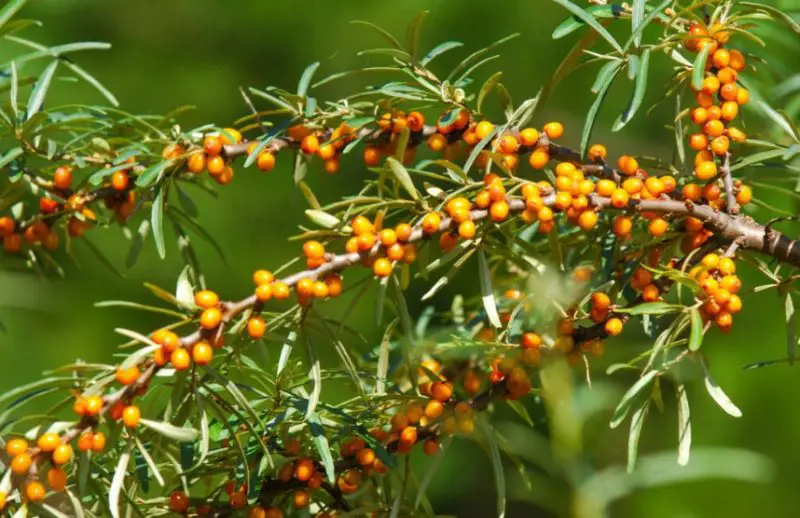
Buckthorn plants are native to both temperate and tropical climates. It is attractive to birds and other wildlife, with bright green leaves and brilliant red fruits that grow to a height of 10 to 15 feet. It has no thorns on it.
While certain varieties of buckthorn are highly valued as ornamentals in yards, others spread quickly to form a dense stand that crowds out or depletes native plants of nutrients, and can be challenging to remove.
Tatarian honeysuckle bush
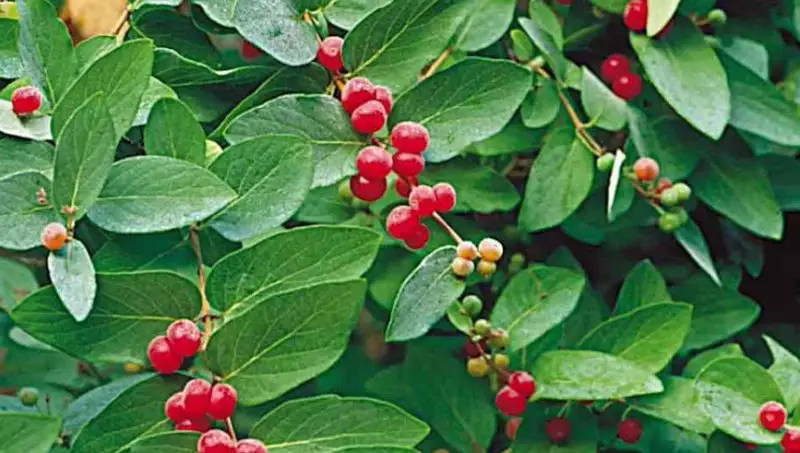
Tatarian honeysuckle bush, sometimes referred to as pink honeysuckle, is a type of honeysuckle shrub that is valued for its quick growth and fragrant, eye-catching blossoms. It is sometimes grown as an ornamental vine in home settings. The inflorescence can be white or have colors ranging from light pink to deep rose.
Wildlife finds the berries to be appealing. Once birds and other animals start eating the fruits, the plant grows quickly into thickets. Roadside ditches, fence rows, thickets, and open forests are among the places where Tatarian honeysuckle can become invasive.
Winterberry

Winterberry is a slow-growing shrub with an upright, rounded growth habit that usually reaches heights of 3 to 15 feet. It easily spreads and suckers to create substantial thickets. While planting in the spring is typically successful as well, it is normally done in late summer or early autumn.
The berry-filled stems of winterberry holly are used to add color to evergreen arrangements, and the plant is frequently connected to the Christmas holiday. When they are leafless and bearing berries in the winter, winterberry branches have a twiggy, dark gray appearance.
Cornelian-cherry dogwood
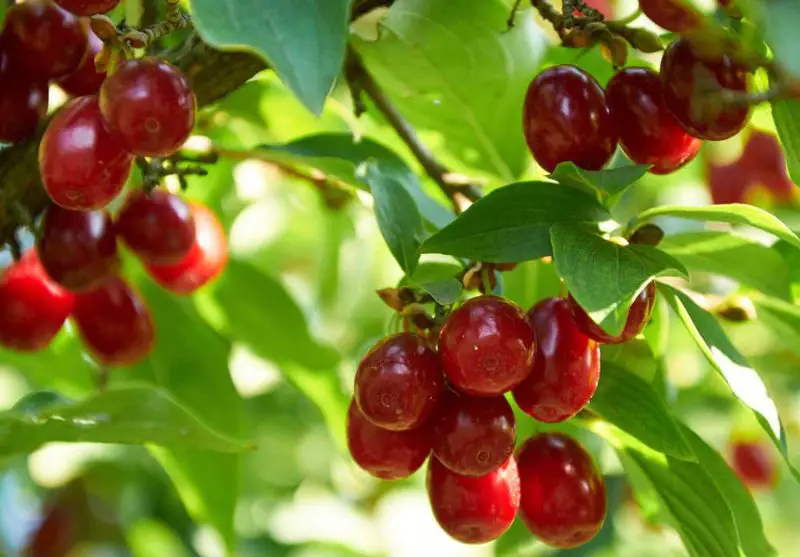
One of the first trees to flower in the spring is the cornelian-cherry dogwood, a small tree or big shrub that grows to a height of 20 to 25 feet. It grows best as a hedge, in masses, next to a patio, or as a specimen plant in well-drained urban environments.
Early in the spring, the tree is covered with dense clusters of tiny yellow blooms that look like stars before the leaves appear. The yellow flower clusters resemble forsythia, and the red stone fruits (drupes) that ripen in July have a shape and size comparable to olives. They are used in European cooking for sauces, syrups, jams, preserves, and drinks.
Peruvian Pepper or Peppercorn Tree
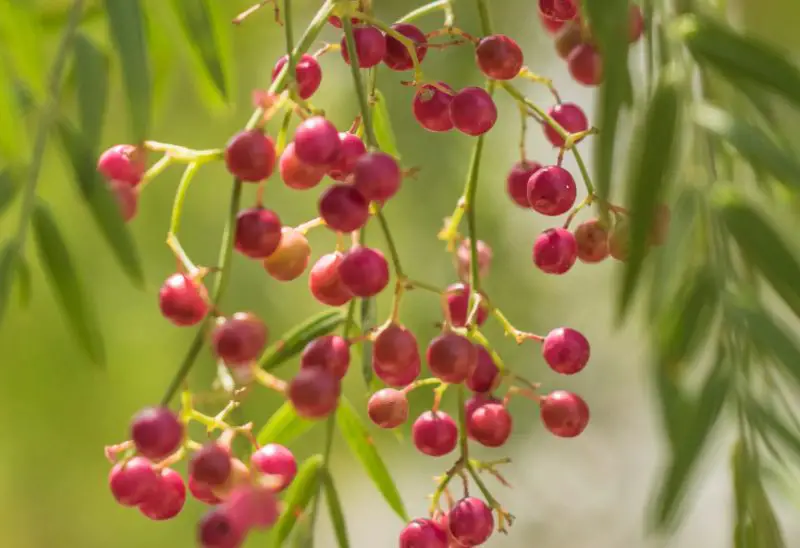
The Peruvian pepper tree is an evergreen that grows quickly, reaching heights and widths of up to 15 meters (50 feet). This evergreen tree grows quickly, and its branches sometimes droop. This drooping canopy, which has a spherical or umbrella shape, covers a large area. When the leaf storage cells of the Peruvian pepper tree are damaged, they release a fragrant oil that has a spicy aroma.
Its tiny, white blooms are borne in profusion in panicles at the tips of drooping branches.There are male and female varieties of these flowers; the female will yield little pink berries known as “peppers.”
American holly tree

A common decorative evergreen for yard focal points and holiday décor is the American holly tree.Mature American hollies reach heights of 40–50 feet and spreads of 3–5 feet. With height growth of fewer than 12 to 24 inches annually, this tree grows slowly to mediumly.
Little chunks of wartiness accentuate the pale gray bark. The robust branchlets are originally green and covered in rusty down, then they become smooth and brown over time. The brown, short, obtuse or acute winter buds are present. The fruit, which is a little red drupe or berry with four seeds, is frequently present throughout the winter.
Hawthorn
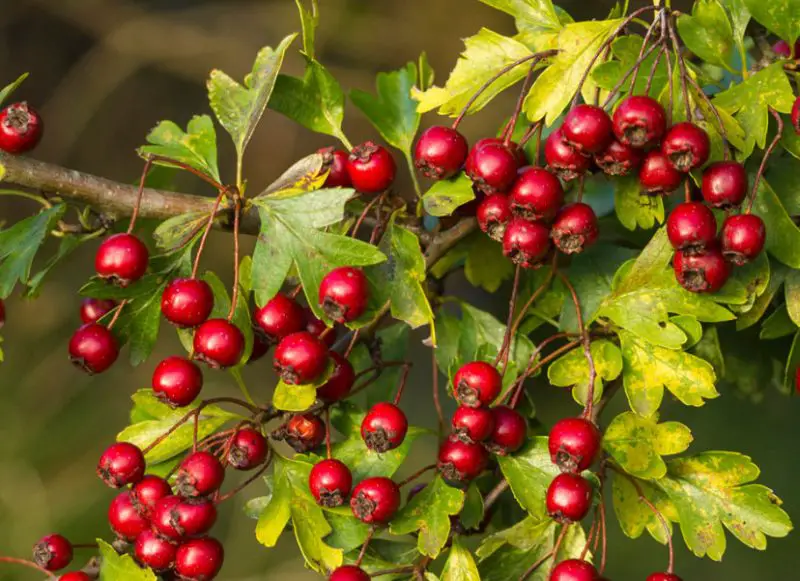
Mature trees can grow as tiny as one stem, but they can also reach a height of fifteen meters. They are distinguished by their dense, prickly nature. The twigs are thin, brown, and covered in thorns; the bark is grey-brown, twisted, and fissured.
The little, apple-like pomes, which can be red, orange, blue, or black, follow the white or pink blooms, which are typically in clusters. The fruits are edible and occasionally employed in herbal medicine, however their flavors and textures differ.
Mock strawberries
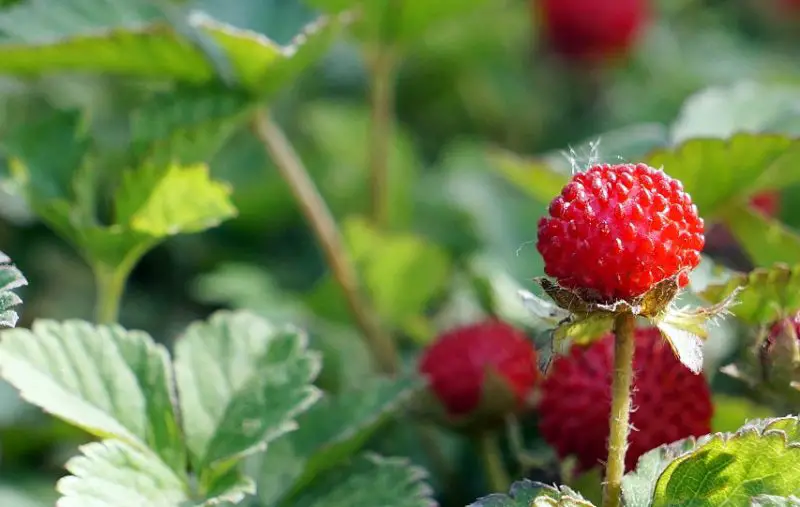
Mock strawberries, also called Indian strawberries, are perennial plants that cling to the ground. spreads by runners to create colonies at ground level in damp lawns and forests. Possibly confused with the local wild strawberry, which grows slowly and has delicious fruit with white petals.
Mock strawberries are tiny, crimson berries that resemble strawberries in appearance but have almost no flavor. The fruit of imitation strawberries is very noticeable because it points upward and away from the ground, in contrast to native wild strawberries.
Red Chokeberry
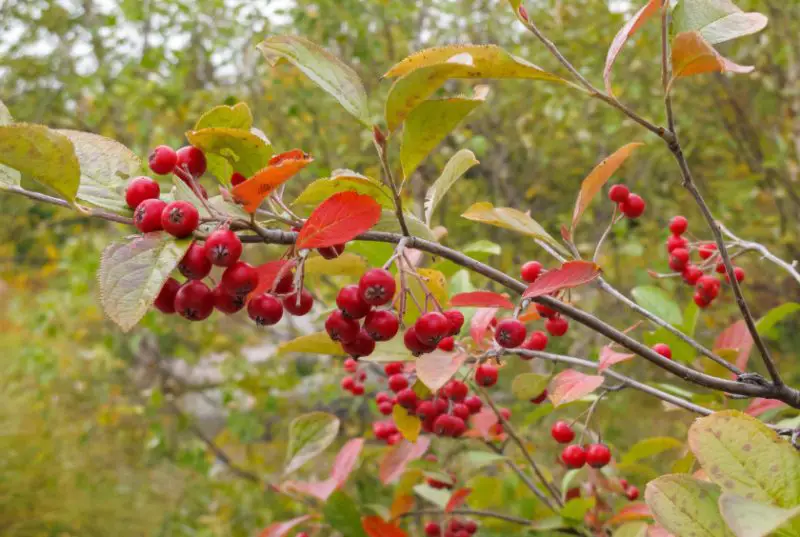
The Red Chokeberry is a shrub that reaches heights of approximately 8 feet and widths of 3 feet. It features red berries from late summer to mid-winter, white blossoms in the spring, and glossy, richly green leaves that change to stunning colors of scarlet, crimson, purple, and orange in the fall.
This plant grows nicely with other shrubs and flowers, bringing interest and color throughout the year. It is a terrific option for natural plantings as well as more structured gardens. Although the berries are unfit for fresh consumption, they yield excellent jams and preserves.
Barberry

The shrubs that bear barberries are covered in yellow blossoms, while the berries themselves are long, red berries. Because of their versatility and low maintenance needs, barberry bushes are hardy deciduous plants that are frequently used as foundation bushes in gardens. Because of their consistent growth pattern, barberries are also widely employed as hedges.
Most barberries are smaller and grow on several stems, but they can reach heights of up to 10 feet, making them roughly the size of small trees.
Red currants
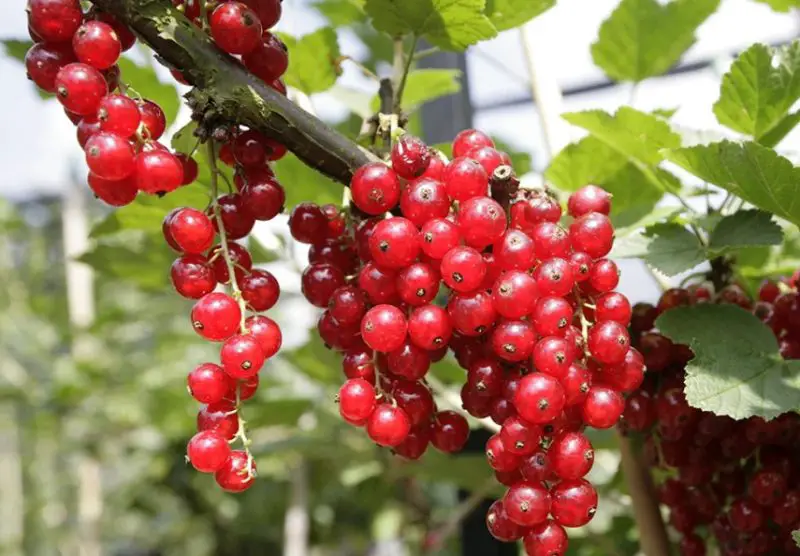
Depending on the cultivar, red currants have clusters of berries that range in color from light red to bright crimson or deep red. Redcurrant bushes are best suited for large gardens or allotments because they are typically cultivated as goblet-shaped bushes that reach a height and spread of 1.5 meters (5′).
Red currant blooms have a yellowish hue in the spring. Red currants are a great accent to any part of your landscape, thanks to their gorgeous, maple-like leaves and upright growth habit.
Red Huckleberries
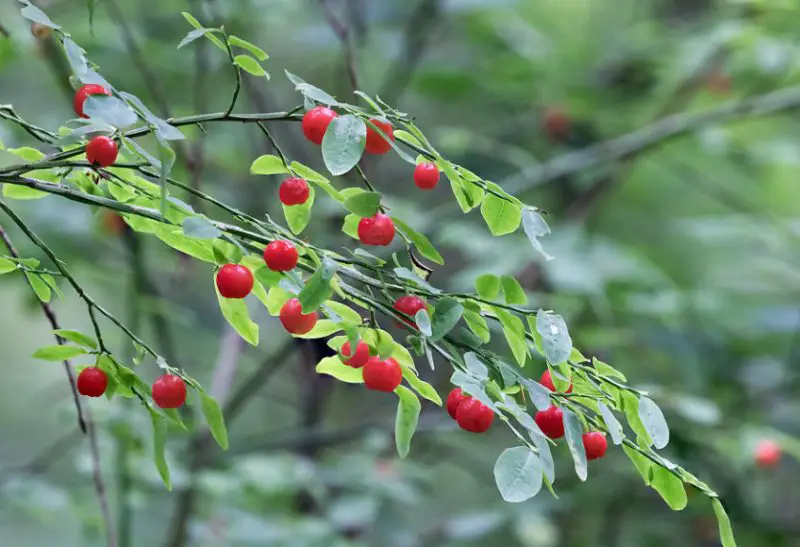
Huckleberries are borne on plants that may reach heights of 10 feet and widths of 5 feet. The leaves are elliptical and thin. Each leaf stem has them arranged in an alternating pattern. The underside of leaves is a lighter hue, while the top is glossy green. On their upper surfaces, leaves are green; underneath, they are paler. The blooms resemble cultivated blueberries when they form.
The crimson, spherical, slightly over-quarter-inch-diameter berries are the result of the pale, waxy, cup-shaped flowers. A ripe red huckleberry has a brilliant red color. Red huckleberry shrubs lose their leaves in the winter, which makes them hard to identify.
Hinnomaki Red gooseberry
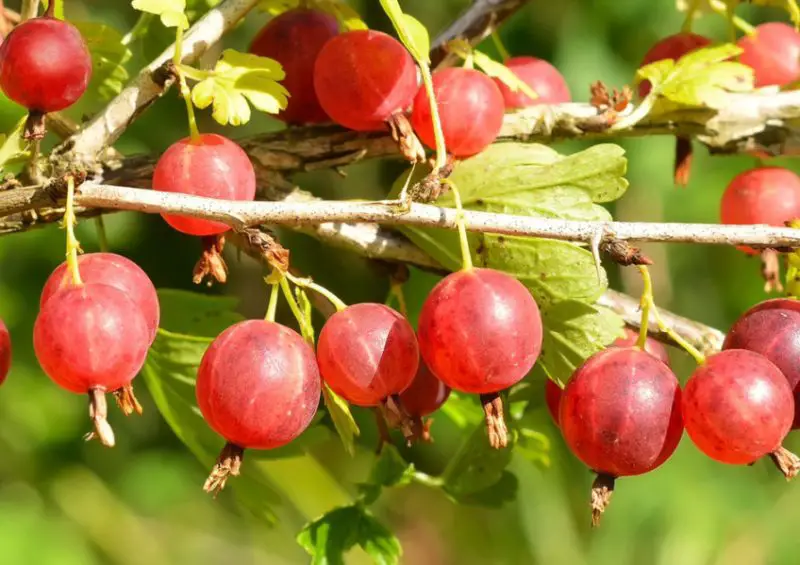
A Finnish gooseberry variety known for its excellent flavor, large yields, and stunning red fruit color is called Hinnomaki Red Gooseberry. The flesh is sweet, but the outer skin is acidic. The plants withstand mildew and grow straight.
These incredibly productive plants can be grown ornamentally or as a hedge in a variety of ways. You can enjoy the luscious berries raw or baked into a pie.
Evans Cherry
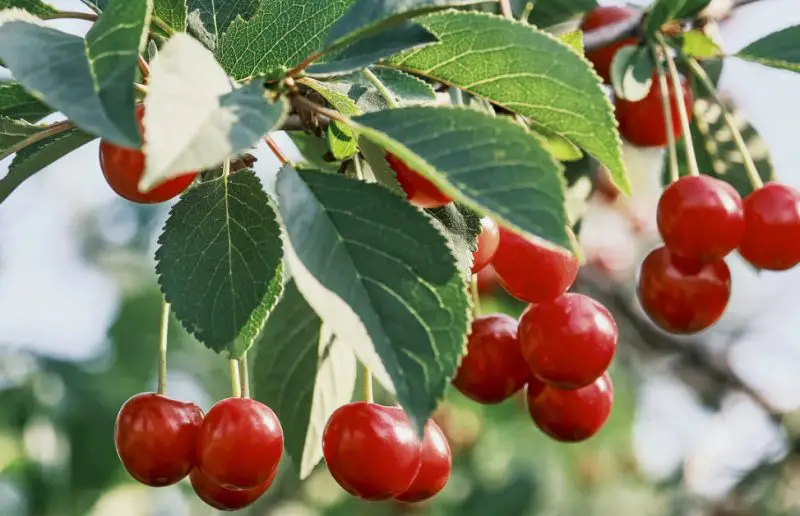
The Evans cherry, sometimes known as the Bali cherry, bears many brilliant red cherries in the middle of summer after producing stunning white blooms in the spring. Before the leaves appear in the middle of spring, the branches of the Evans cherry are covered in gorgeous clusters of fragrant white blossoms.
All season long, its foliage is a deep green color. In the fall, the sharp leaves turn a striking orange. If the falling cherry fruits fall onto the grass or walkways, it could get nasty. Because it is a self-pollinating cultivar, fruiting doesn’t depend on the presence of another plant nearby.
Linden viburnum
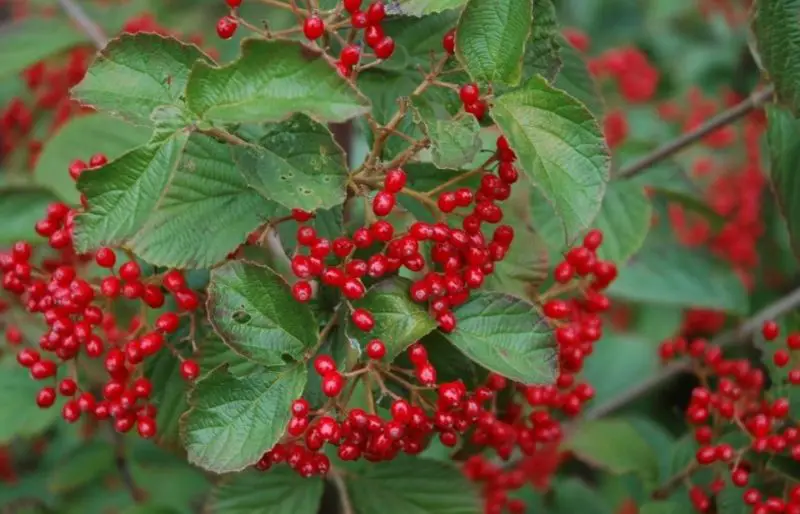
Because of its similarities to linden tree leaves, the linden viburnum derives its common name. Grows to a height of 8–10 feet and a width of 6–8 feet.As the stems age, their color changes from brown to a dark gray. The stems are pubescent and have brown bark with some orange.
Following the clusters of white flowers in the spring are red, glabrous, fleshy, spherical drupes that develop in similar clusters to the flowers and become black in the fall and winter.
Highbush cranberry
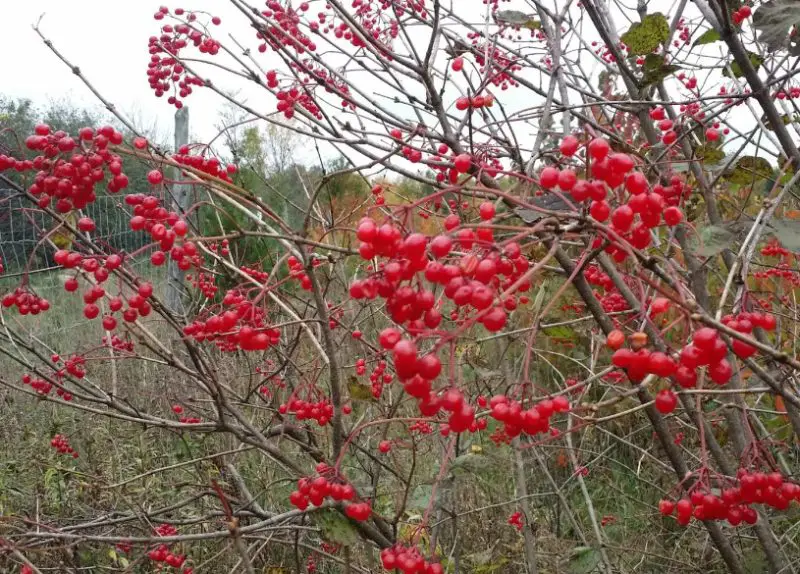
Although the fruit of the highbush cranberry, or “drupes” as they are known taxonomically, closely resembles cranberries in both appearance and flavor, it is not a cranberry at all. Like cranberries, they ripen in the fall as well. The blooms of highbush cranberry plants create a striking sight in the springtime when they contrast with the rich, deep green foliage.
Similar to lacecap hydrangeas, the flower clusters include a ring of enormous, sterile blooms surrounding a center composed of small, fertile flowers. In the fall, when they are laden with vivid red or orange berries that dangle from stems like cherries, these plants reclaim the spotlight.
American bittersweet
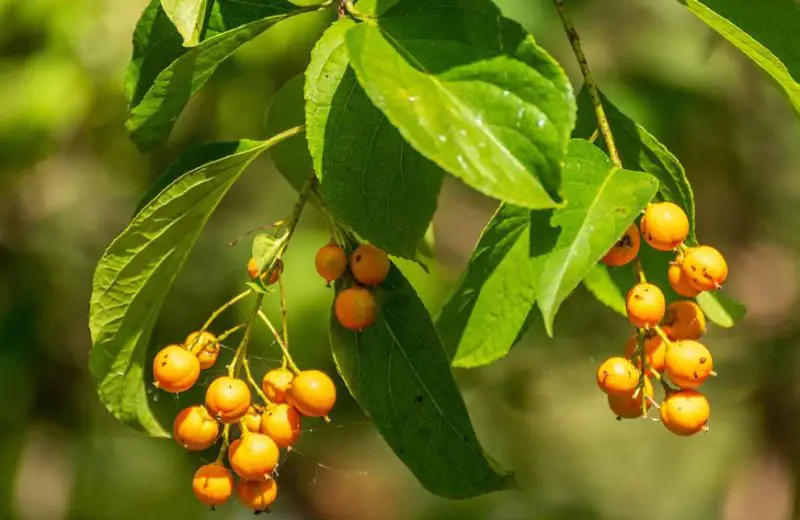
The robust deciduous perennial vine known as American bittersweet can reach heights of 15 to 20 feet and spreads swiftly, covering walls, fences, trees, and arbors. Its brilliant red berries and yellow autumn leaves are what make it most famous.
You will need both a male and female plant while cultivating bittersweet for the beautiful berries. Only when a male plant is close by to fertilize the blossoms will the female plants provide berries.
Nanking Cherries
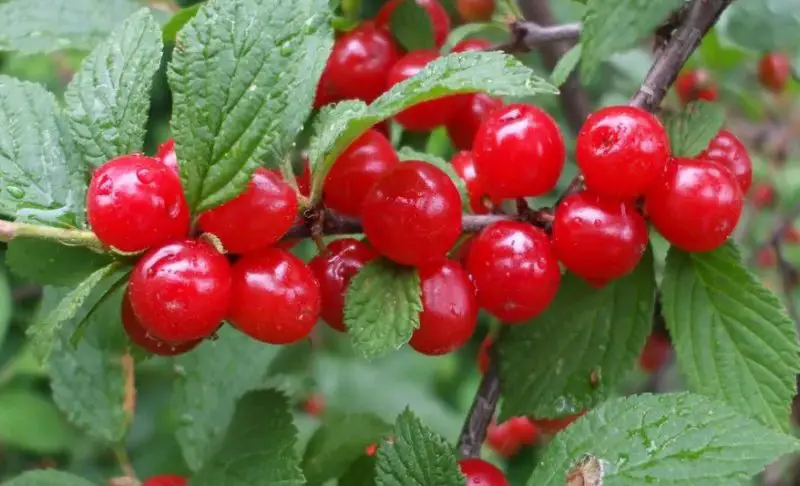
A lovely, rounded ornamental shrub that offers year-round color is the Nanking Cherry. Pink buds bloom into fragrant white or pale pink flowers in the early spring. The medium-sized shrub that bears nanking cherries can grow up to 2.5 meters tall.
Clusters of little red fruits, known as drupes, are borne on short stems. The fruit clusters are positioned sporadically around the branches, tucked in between the foliage.
Strawberries
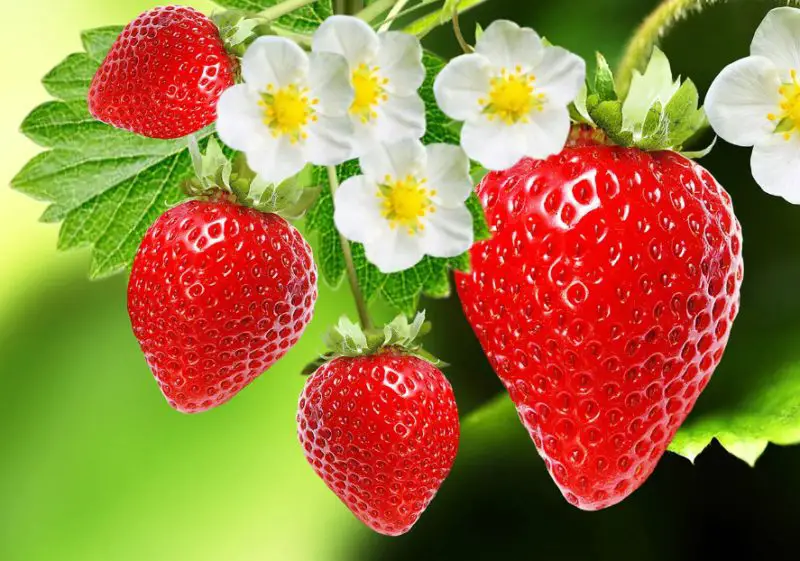
The ends of the plant’s stamens are what are known as strawberries, not berries or actual fruit. In reality, the little black dots on the “berry” are the fruits of strawberries. Typically, a strawberry has 150–200 seeds on its surface, and its flowers have five to seven petals.
The majority of strawberry plants reproduce through runners, though the seeds can sprout to form new plants. Strawberry plants can develop tangled colonies that can last up to 50 years under specific circumstances.
Common Spindle
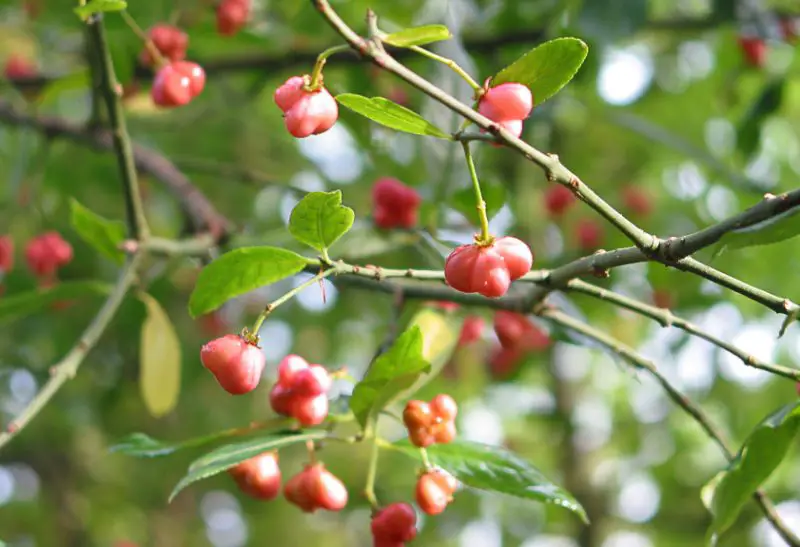
The common spindle, often called European spindle, is a deciduous plant that grows up to 30 feet tall as a big shrub or small tree. Perhaps the strangest of all our natural shrubs and bushes are spindle fruits. When they are ripe, their green “capsules” turn a vibrant scarlet color.
This plant produces oil that is used to make soap. Artists value the charcoal made from the wood, and the seed coating is used to make a yellow dye.
Red Elderberry
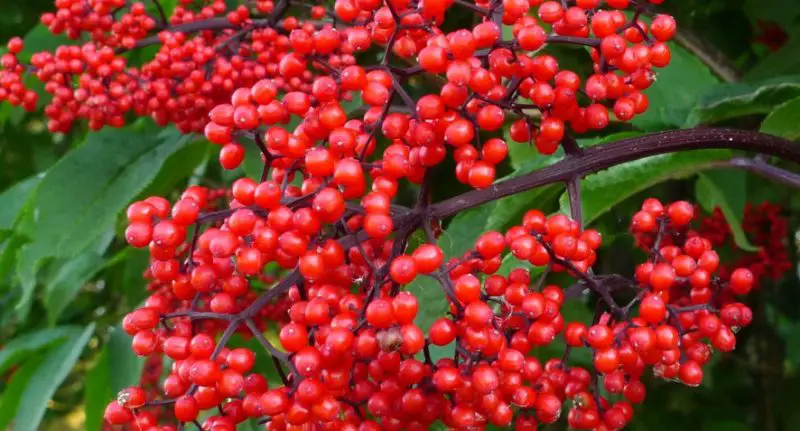
Shrubs that usually reach a height of 5 to 12 feet are called elderberries, though some can reach up to 20 feet. In the garden, these higher elderberry bushes frequently resemble multistemmed trees. The deciduous leaves on elderberry bushes range in length from five to nine inches. Their small light flowers grow in large clusters up to one foot in diameter.
Elderberry bushes are particularly identifiable in the summer when the blossoms bloom because of these striking clusters. In summer and early fall, the black, berry-like fruit also develops in clusters; each fruit has a diameter of about 1/4 inch.
Raspberries
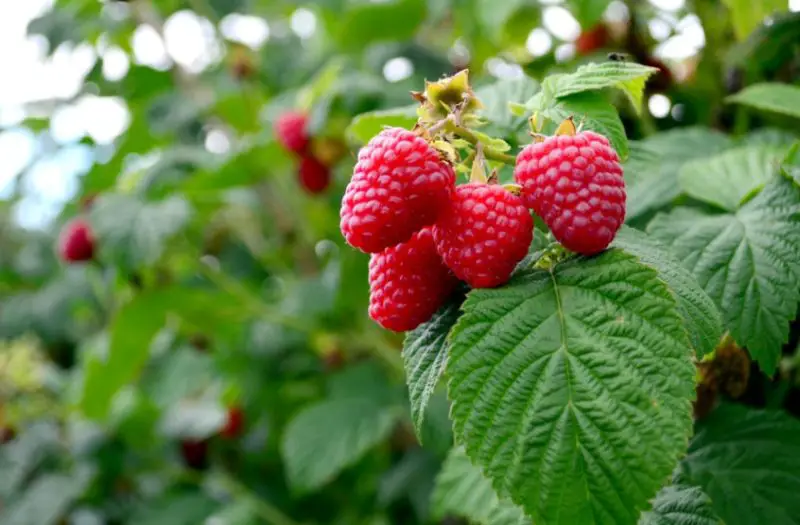
The short-lived, prickly canes and antioxidant-rich berries that raspberries, a fast-growing, deciduous shrub, typically produce in large quantities throughout the summer and fall.
If left unchecked, they have the potential to spread out in any direction and quickly become a dense clump of brambles. In order to help prevent illnesses, raspberries grow best in an open, exposed, sunny area with lots of air movement.
Butcher’s broom
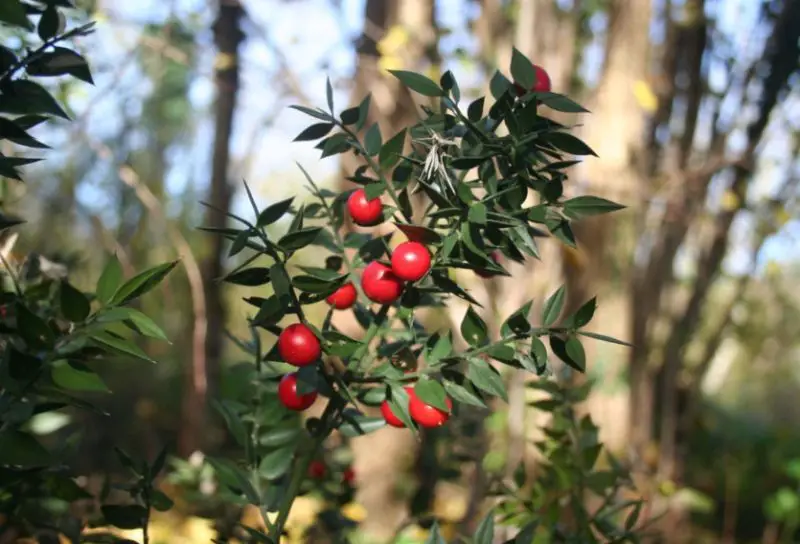
The butcher’s broom is a bushy, evergreen subshrub that can reach a height of three feet. It has flat stems called cladodes that resemble stiff, spine-tipped leaves. Tiny greenish flowers are borne singly in the center of the cladodes and first appear in the spring. The plant also multiplies vegetatively by rhizomes. The female blooms are followed by a red berry, and birds disperse the seeds.
The year-round availability of the stems makes them a beautiful and sturdy foliage for cut flower arrangements. Stems cut in late fall or early winter can be kept for up to five months in the refrigerator.
Buffalo Berry
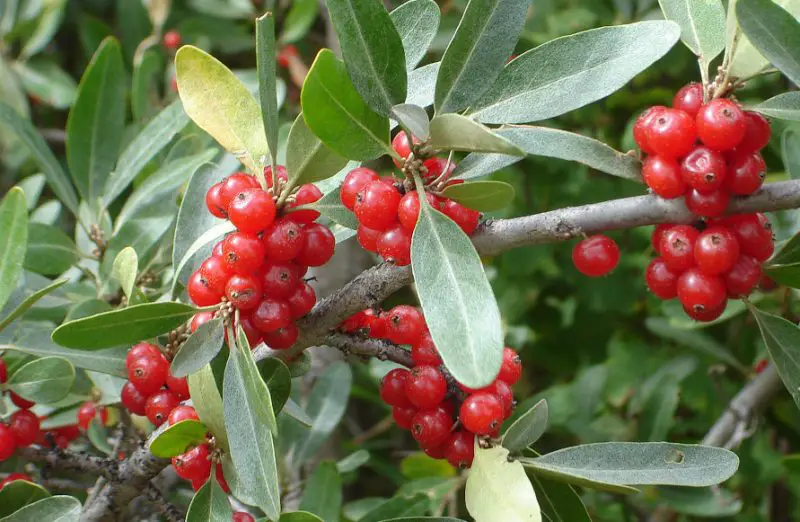
The buffalo berry is a shrub that grows to a height of 2 to 6 meters, or 6 to 20 feet. The small, oblong, silvery leaves are borne on rather prickly, white branches. The fruit is a currant-sized, tart-flavored, scarlet-red or golden-yellow berry that is borne in abundance in August or September.
It is prized as an ornamental and hedge plant in areas where other shrubs frequently die because it can withstand windswept locations on dry, rocky soil. Berries are used to produce jelly and meat relish.






